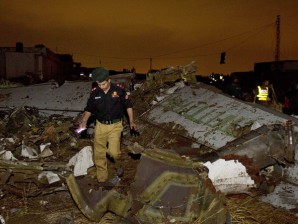
‘NO SURVIVORS.’ Pakistani rescue workers sort through the wreckage of the Boeing 737 passenger plane that crashed in the outskirts of Islamabad, Pakistan, Friday, April 20, 2012. Sobbing relatives of those on the flight, which was coming from Karachi, flocked to the airport, and officials said there appeared to be no survivors from the 127 people on board. AP/Anjum Naveed
ISLAMABAD — Emergency workers with flashlights searched the smoldering wreckage of a passenger jet carrying 127 people that crashed into a muddy wheat field Friday while trying to land in a violent thunderstorm at Islamabad’s main airport.
The government said there appeared to be no survivors in the crash of the Boeing 737-200 near Benazir Bhutto International Airport — the second major air disaster in the Pakistani capital in less than two years.
Sobbing relatives of those aboard the Bhoja Air flight from Karachi to Islamabad rushed to airports in both cities for news of their loved ones.
One rescue official asked residents to bring sheets to cover the remains of the dead, and smashed seats and other wreckage was spread over a wide area near the airport, along with clothing and jewelry belonging to passengers.
Bhoja Air, a domestic carrier that has just four planes, only resumed operations last month after suspending them in 2001 due to financial difficulties.
Bhoja administrative director Javed Ishaq told reporters and relatives of those on board that the jet was in good condition and was brought down by “heavy winds.”
“The aircraft was in good shape. This came from God,” said Ishaq, speaking at the airport in Karachi, Pakistan’s largest city. As he spoke, relatives of those aboard who had come to the airport jeered him and demanded to be flown to Islamabad to collect the bodies of their loved ones.
The plane had been given clearance to land, said an air traffic controller who did not give his name because he was not authorized to speak to the media. A violent thunderstorm was lashing Islamabad at the time of the crash, about 6:40 p.m. local time.
“It was really bad weather for a flight,” said navy Capt. Arshad Mahmood, who lives near the crash site. “The pilot was forced to move down to avoid clouds that were generating the lightning and thunder.”
Islamabad police chief Bani Yameen said nobody on the ground was reported killed, “but apparently all on board perished.” Civil aviation officials also said survivors were highly unlikely, according to Defense Minister Chaudhry Ahmed Mukhtar.
“My brother’s wife was on board this flight,” said Naveed Khan. “We pray for the departed souls. What else can we do now?”
TV footage showed wreckage that included parts of what looked like an engine and a wing against the wall of a small building. Rescuers worked in the dark, with many using flashlights as they combed the area. Fleets of ambulances arrived later, their lights flashing in the gloom.
Several farmers threshing wheat in the field nearby said they saw the aircraft burst into flames when it hit the ground.
“The flames leapt up like they were touching the sky,” said Mohammad Zubair.
The army declared an emergency and cordoned off the crash site.
“I saw nothing but body parts and twisted metal on the ground when I reached the scene,” said resident named Mustafa, who did not identify himself further.
He said residents collected the remains of the dead “and bundled them in cloth sheets like we collect grain.”
A Pakistani relative of passengers flying on the plane which crashed in Islamabad, reacts at Jinnah International airport in Karachi. AP
In a statement, the Boeing Co. extended its condolences to the families of the victims and offered technical assistance to Pakistan’s Civil Aviation Authority in investigating the crash.
The last major plane crash in the country — and Pakistan’s worst — occurred in July 2010 when an Airbus A321 aircraft operated by domestic carrier Airblue crashed into the hills overlooking Islamabad, killing all 152 people aboard. A government investigation blamed the pilot for veering off course amid stormy weather.
Bhoja Air started domestic operations in Pakistan in 1993 and eventually expanded to international flights to the United Arab Emirates in 1998. The company suspended operations in 2001 due to financial difficulties but resumed them in 2012.
First posted 11:15 pm | Friday, April 20th, 2012